Are Snakes Good Pets For Beginners? Absolutely! At PETS.EDU.VN, we believe introducing a snake into your life can be an enjoyable and educational experience. These reptiles, often misunderstood, offer a unique companionship that is both fascinating and surprisingly low-maintenance. This guide will explore why certain snake species make excellent first pets and how to care for them properly, ensuring a rewarding journey for both you and your scaly friend. Unlock the secrets to reptile ownership and discover a new world of animal companionship with PETS.EDU.VN.
1. Understanding the Appeal of Snakes as Pets
Many potential pet owners shy away from snakes due to misconceptions and fear. However, snakes can be wonderful companions, offering several unique benefits. They are quiet, relatively clean, and don’t require the constant attention that mammals like dogs or cats need. Additionally, snakes come in a variety of colors, sizes, and personalities, making it easy to find one that suits your lifestyle. Their housing requirements are generally simple, and once set up, they require minimal daily care. For those interested in exotic pets but lack the time for a high-maintenance animal, snakes present an attractive option. With their increasing popularity, many resources and communities are available to support new snake owners, ensuring a smooth and enjoyable experience.
2. Factors to Consider Before Getting a Snake
Before bringing a snake home, careful consideration of several factors is crucial to ensure both your and the snake’s well-being. Understanding these aspects will help you choose the right species and provide the necessary care.
2.1. Species Selection
Choosing the right snake species is the first and most important step. Different species have varying temperaments, sizes, and care requirements. Beginner-friendly snakes are typically docile, easy to handle, and have relatively simple needs. Popular options include corn snakes, ball pythons, and California king snakes. Researching each species’ specific needs is essential before making a decision. At pets.edu.vn, we provide detailed care sheets for numerous snake species, helping you make an informed choice.
2.2. Size and Enclosure Requirements
Consider the adult size of the snake and the corresponding enclosure size needed. Snakes need secure enclosures that prevent escape and maintain the appropriate temperature and humidity levels. A larger snake will require a significantly larger enclosure, which can impact your living space and budget. Ensure you have enough room for the appropriate-sized tank, along with any necessary heating and lighting equipment.
2.3. Diet and Feeding Habits
Snakes are carnivores and primarily eat rodents or other small animals. Most pet snakes are fed frozen-thawed prey, which is convenient and safe. However, some snakes can be picky eaters, which can be challenging for beginners. Understanding the specific dietary needs of your chosen species is essential. Also, consider the cost and availability of the appropriate food.
2.4. Temperament and Handling
Snakes have varying temperaments. Some are docile and tolerate handling well, while others are more defensive or shy. For beginners, choosing a snake with a calm temperament is advisable. Regular, gentle handling can help your snake become more comfortable with you. However, it is important to respect your snake’s boundaries and avoid handling it when it is stressed or shedding.
2.5. Lifespan and Long-Term Commitment
Snakes can live for many years, with some species living over 20 years. Owning a snake is a long-term commitment, and it is essential to be prepared for the responsibility. Consider whether you are willing to provide the necessary care and attention for the duration of the snake’s life.
2.6. Legal Considerations
Before acquiring a snake, check your local and state laws regarding reptile ownership. Some areas have restrictions on certain species or require permits. Ensure you comply with all legal requirements to avoid potential fines or other issues.
2.7. Veterinary Care
Snakes can get sick and require veterinary care. Finding a veterinarian experienced in treating reptiles is essential. Regular check-ups can help detect potential health problems early. Be prepared for the costs associated with veterinary care, including exams, medications, and potential surgeries.
2.8. Cost of Ownership
The cost of owning a snake includes the initial purchase price, enclosure, heating and lighting equipment, substrate, food, and veterinary care. While snakes are generally less expensive than some other pets, the costs can still add up. Create a budget and ensure you can afford the ongoing expenses of snake ownership.
3. Top 8 Beginner-Friendly Snake Species
Now that you know what to consider, let’s dive into the top beginner-friendly snakes that offer a great combination of ease, temperament, and low maintenance. These species are known for being docile, hardy, and relatively easy to care for, making them ideal for first-time snake owners.
3.1. Corn Snake (Pantherophis guttatus)
The corn snake remains a top choice for beginners. Growing between 2 and 6 feet (0.61 and 1.82 meters), these snakes are known for their vibrant colors and calm temperaments. Corn snakes are native to North America, making them well-adapted to various climates.
Despite their name, corn snakes don’t eat corn; they allegedly got the name from being found in cornfields, where they hunt rodents (hence their categorization as rat snakes). They’re excellent escape artists, so make sure to lock up their enclosure tightly. These nonvenomous constrictors thrive on a diet of frozen-then-thawed mice, and their habitat needs are simple, with a warm side and a cool side. They’re also very easy to handle, making them perfect for first-time snake owners who are a little nervous about interacting with them.
| Feature | Description |
|---|---|
| Size | 2-6 feet (0.61-1.82 meters) |
| Temperament | Calm, docile |
| Diet | Frozen-thawed mice |
| Enclosure Needs | Secure enclosure with warm and cool sides |
| Handling | Easy to handle |
| Lifespan | 15-20 years |
| Origin | North America |
| Activity Pattern | Diurnal (active during the day), making them enjoyable to watch |
| Beginner Friendly | Yes |
| Price Range | $20-$150 (depending on morph) |
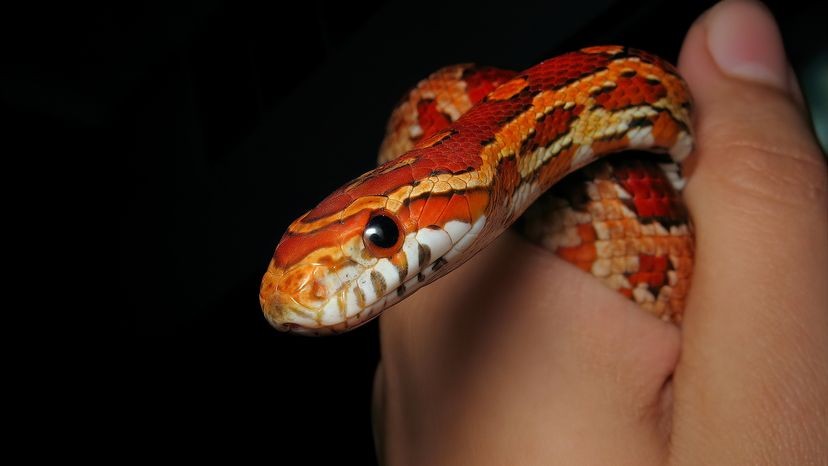
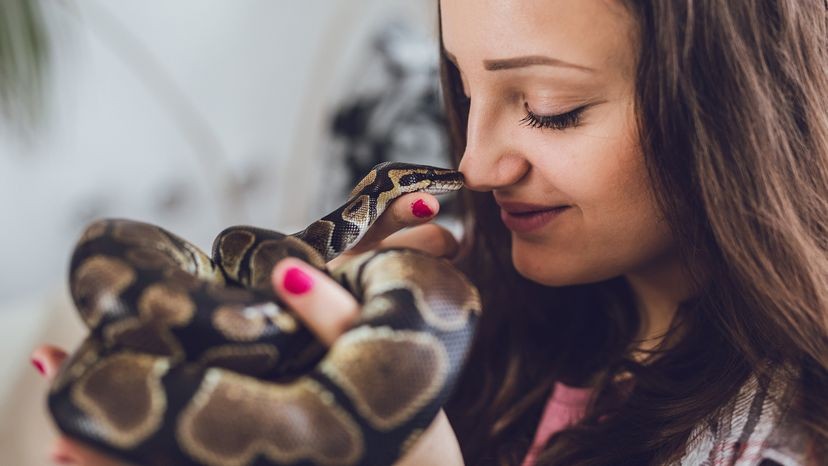

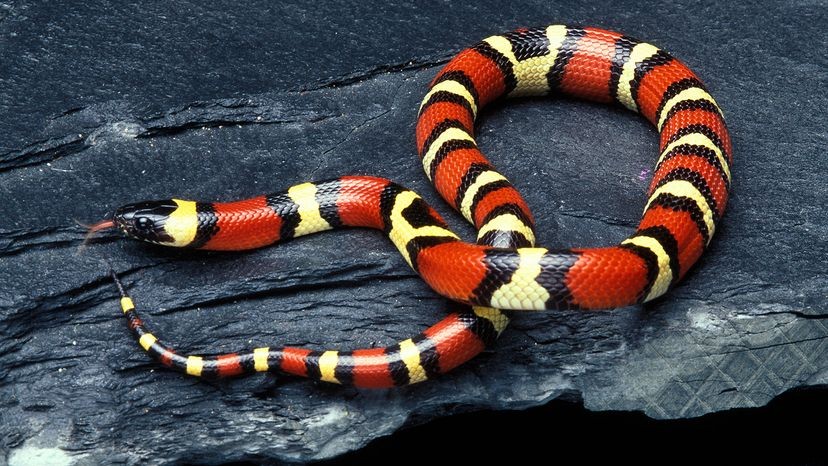
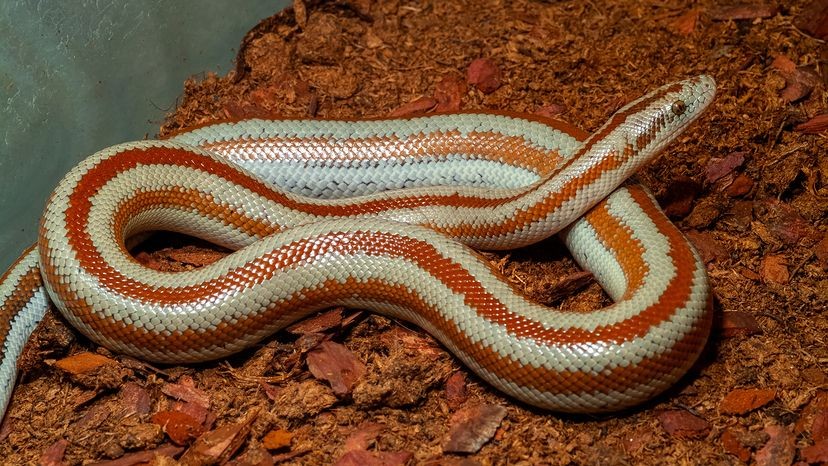


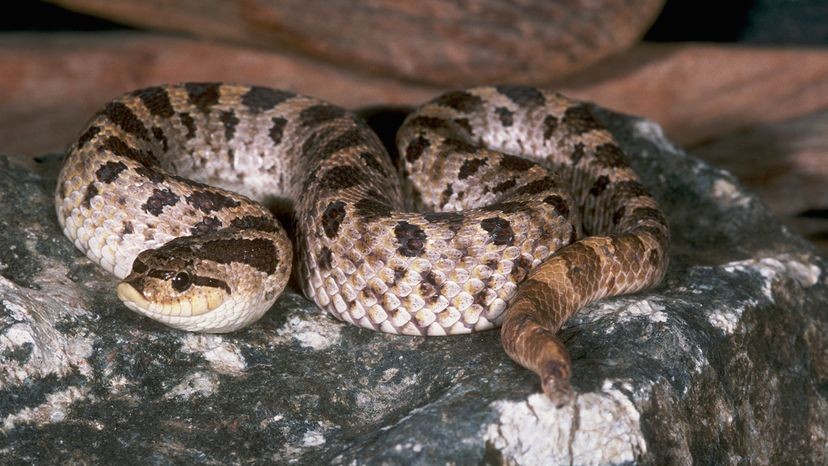
3.2. Ball Python (Python regius)
The ball python is a popular choice for beginners due to its gentle nature. Adult ball pythons typically grow to 3 to 5 feet (0.9 to 1.5 meters) in length, with some individuals reaching up to 6 feet (1.8 meters). They are native to Central and West Africa, where they inhabit grasslands and forests.
When threatened, they curl up into a tight ball, which is how they got their name. Their wide range of color morphs also adds to their appeal, making them a favorite among snake enthusiasts. While these snakes are great for beginners due to their calm nature, they can be a bit high-maintenance when it comes to their environment. They need specific temperature and humidity levels and can be picky eaters, sometimes refusing food for weeks. Proper care with their enclosure and feeding is essential, making them more demanding than some other beginner snakes like corn snakes.
| Feature | Description |
|---|---|
| Size | 3-5 feet (0.9-1.5 meters), up to 6 feet (1.8 meters) |
| Temperament | Gentle, docile |
| Diet | Frozen-thawed mice |
| Enclosure Needs | Specific temperature and humidity levels |
| Handling | Calm nature, good for handling |
| Lifespan | 20-30 years |
| Origin | Central and West Africa |
| Activity Pattern | Crepuscular (active during twilight), but can adapt to day activity with handling |
| Beginner Friendly | Yes, but requires attention to environment |
| Price Range | $30-$500+ (depending on morph) |
3.3. California King Snake (Lampropeltis californiae)
The California king snake is a striking black-and-white banded species, typically growing to 3 to 4 feet (0.9 to 1.2 meters) in length. Known for their hardiness and adaptability, they make perfect pet snakes for beginners. They are native to the western United States and Baja California, inhabiting a variety of habitats from deserts to woodlands.
However, they like to be the “king” (or “queen”) of their space, so it’s best to house them alone, as they may attempt to dominate or even eat other snakes. Their curious and active nature makes them fun to watch, and they easily feed on frozen-then-thawed rodents. With their bold patterns and confident demeanor, California king snakes are a great choice for those seeking lively and engaging pet reptiles.
| Feature | Description |
|---|---|
| Size | 3-4 feet (0.9-1.2 meters) |
| Temperament | Hardy, adaptable, active |
| Diet | Frozen-thawed rodents |
| Enclosure Needs | Secure enclosure, solitary housing |
| Handling | Confident demeanor, good for handling |
| Lifespan | 10-15 years |
| Origin | Western United States and Baja California |
| Activity Pattern | Diurnal (active during the day), making them enjoyable to watch |
| Beginner Friendly | Yes, but house alone |
| Price Range | $20-$80 (depending on morph) |
3.4. Milk Snake (Lampropeltis triangulum)
Milk snakes are a visually striking species with their vibrant red, black, and yellow bands, making them popular among snake enthusiasts. They grow to a manageable size of 2 to 4 feet (0.6 to 1.2 meters), making them ideal for beginners. Milk snakes are found throughout North, Central, and South America, with various subspecies exhibiting different color patterns and sizes.
Known for being good eaters, they readily accept frozen-then-thawed rodents and have straightforward care requirements. While milk snakes are generally docile, they can be a bit squirmy at first; gentle, regular handling helps them become more comfortable over time. Their combination of beauty, low-maintenance care, and calm temperament makes them a favorite choice for new snake owners.
Milk snakes are often confused with venomous coral snakes due to their similar banding. A simple rhyme — “Red on yellow, kill a fellow; red on black, friend of Jack” — is a handy way to distinguish harmless milk snakes from their dangerous lookalikes.
| Feature | Description |
|---|---|
| Size | 2-4 feet (0.6-1.2 meters) |
| Temperament | Docile, can be squirmy at first |
| Diet | Frozen-thawed rodents |
| Enclosure Needs | Straightforward care requirements |
| Handling | Gentle, regular handling helps |
| Lifespan | 12-20 years |
| Origin | North, Central, and South America |
| Activity Pattern | Crepuscular (active during twilight), but can adapt to day activity with handling |
| Beginner Friendly | Yes |
| Price Range | $30-$100 (depending on morph) |
3.5. Rosy Boa (Lichanura trivirgata)
The rosy boa is a small, calm snake, typically growing to about 2 to 3 feet (0.6 to 0.9 meters), making it an ideal choice for beginner snake pets. They are native to the southwestern United States and Mexico, where they inhabit arid and semi-arid environments.
Its striking appearance, with rosy or grayish hues and three distinct stripes running along its body, makes it a visually appealing pet. These snakes love to burrow, so providing them with a deep substrate, like aspen shavings or coconut husk, is essential to meet their natural behavior. Rosy boas are nonvenomous and require minimal care. A properly heated terrarium, along with a diet of frozen-then-thawed feeder mice, will keep them healthy.
| Feature | Description |
|---|---|
| Size | 2-3 feet (0.6-0.9 meters) |
| Temperament | Small, calm |
| Diet | Frozen-thawed feeder mice |
| Enclosure Needs | Deep substrate for burrowing |
| Handling | Calm and easy to handle |
| Lifespan | 20-30 years |
| Origin | Southwestern United States and Mexico |
| Activity Pattern | Nocturnal (active at night), but can adapt to day activity with handling |
| Beginner Friendly | Yes |
| Price Range | $50-$150 (depending on morph) |
3.6. Garter Snake (Thamnophis sirtalis)
The garter snake is a good choice for beginners, particularly due to its manageable size, typically reaching 2 to 3 feet (0.6 to 0.9 meters) in length, and its active, curious personality. Garter snakes are among the most widespread snake species in North America, found in a variety of habitats from forests to grasslands.
This snake species is easily recognized by the distinctive stripes running along its body, which can vary in color depending on the specific type of garter snake. They are lively and love to explore their environment, making them an engaging pet. One of the unique features of garter snakes is their varied diet, which sets them apart from other snake species. They can eat a mix of fish, worms, and small amphibians, though they will also happily accept frozen-then-thawed mice. This flexibility makes feeding them easier and more diverse. Known for being hardy and adaptable, garters are well-suited to a variety of habitats and are relatively easy to care for.
| Feature | Description |
|---|---|
| Size | 2-3 feet (0.6-0.9 meters) |
| Temperament | Active, curious |
| Diet | Fish, worms, small amphibians, frozen-thawed mice |
| Enclosure Needs | Adaptable to various habitats |
| Handling | Lively and engaging |
| Lifespan | 5-10 years |
| Origin | North America |
| Activity Pattern | Diurnal (active during the day), making them enjoyable to watch |
| Beginner Friendly | Yes |
| Price Range | $10-$50 (depending on morph) |
3.7. Kenyan Sand Boa (Eryx colubrinus)
The Kenyan sand boa is perfect for those who prefer a smaller burrowing snake. Typically reaching 1.5 to 2 feet (0.45 to 0.6 meters) in length, this boa is known for its thick, rounded body and striking orange and brown patterns. Their small size and manageable nature make them ideal for beginner snake owners. They are native to East Africa, where they inhabit arid and semi-arid regions.
As their name suggests, Kenyan sand boas love to burrow and spend much of their time hidden under the substrate, often in aspen bedding or sand. This burrowing behavior makes them a bit shy, but their docile temperament and gentle nature make them easy to handle. They are also incredibly low-maintenance, thriving in a simple enclosure. Their diet consists of frozen-then-thawed mice, and they require relatively infrequent feeding due to their slower metabolism. Despite their reclusive habits, these boas are great pets for beginners looking for a calm, easy-to-care-for snake that won’t outgrow their space.
| Feature | Description |
|---|---|
| Size | 1.5-2 feet (0.45-0.6 meters) |
| Temperament | Docile, gentle |
| Diet | Frozen-thawed mice |
| Enclosure Needs | Aspen bedding or sand for burrowing |
| Handling | Easy to handle |
| Lifespan | 20-30 years |
| Origin | East Africa |
| Activity Pattern | Nocturnal (active at night), but can adapt to day activity with handling |
| Beginner Friendly | Yes |
| Price Range | $40-$120 (depending on morph) |
3.8. Western Hognose Snake (Heterodon nasicus)
The western hognose snake is a small, quirky snake known for its distinctive upturned snout, which it uses to dig and burrow in the substrate. Reaching a length of 2 to 3 feet (0.6 to 0.9 meters), this snake’s manageable size and friendly temperament make it a great choice for beginners. They are native to North America, inhabiting grasslands and prairies.
One of the most entertaining aspects of the western hognose is its dramatic defensive behavior. When threatened, it may puff up, hiss, and even play dead, but don’t worry; it’s all for show, as they are harmless and nonvenomous. Western hognoses thrive in enclosures that provide plenty of space for burrowing in materials like aspen shavings or coconut fiber. Their diet consists primarily of frozen-then-thawed rodents, and they are relatively low-maintenance pets.
| Feature | Description |
|---|---|
| Size | 2-3 feet (0.6-0.9 meters) |
| Temperament | Friendly, quirky |
| Diet | Frozen-thawed rodents |
| Enclosure Needs | Aspen shavings or coconut fiber for burrowing |
| Handling | Manageable size, friendly temperament |
| Lifespan | 10-18 years |
| Origin | North America |
| Activity Pattern | Diurnal (active during the day), making them enjoyable to watch |
| Beginner Friendly | Yes |
| Price Range | $80-$200 (depending on morph) |
4. Setting Up the Perfect Snake Enclosure
Creating the right environment for your snake is critical to its health and well-being. A properly set-up enclosure mimics the snake’s natural habitat and provides everything it needs to thrive. Here’s how to set up the perfect snake enclosure:
4.1. Choosing the Right Enclosure
The size of the enclosure depends on the size of the snake. A general rule is that the length of the enclosure should be at least two-thirds the length of the snake. Glass terrariums are a popular choice because they are easy to clean and provide good visibility. Plastic enclosures are also an option, particularly for snakes that require high humidity. Ensure the enclosure has a secure lid to prevent escape.
4.2. Substrate
Substrate is the material that lines the bottom of the enclosure. Different substrates have different properties and are suitable for different species. Popular options include:
- Aspen shavings: Good for burrowing snakes and easy to clean.
- Coconut fiber: Retains moisture and is ideal for snakes that require high humidity.
- Paper towels: A simple and inexpensive option, particularly for quarantine or sick snakes.
- Reptile carpet: Easy to clean but can harbor bacteria if not properly maintained.
4.3. Heating
Snakes are ectothermic, meaning they rely on external heat sources to regulate their body temperature. Provide a temperature gradient within the enclosure, with a warm side and a cool side. This allows the snake to move between different temperatures to regulate its body temperature.
- Undertank heaters: Placed under the enclosure to provide a warm spot.
- Ceramic heat emitters: Provide heat without light and are ideal for nighttime heating.
- Heat lamps: Provide both heat and light, but can dry out the enclosure.
Use a thermostat to regulate the temperature and prevent overheating. Monitor the temperature with thermometers placed on both the warm and cool sides of the enclosure.
4.4. Lighting
While snakes don’t require UVB lighting like some other reptiles, providing a day/night cycle can be beneficial. A simple fluorescent or LED light can provide ambient light during the day. Turn off the lights at night to allow the snake to rest.
4.5. Humidity
Maintaining the proper humidity level is essential for the snake’s health. Use a hygrometer to monitor the humidity level. Different species have different humidity requirements. Increase humidity by misting the enclosure with water or providing a water bowl. Decrease humidity by improving ventilation.
4.6. Hides
Snakes need hiding places to feel secure. Provide at least two hides, one on the warm side and one on the cool side of the enclosure. Hides can be made from rocks, logs, or commercially available reptile hides.
4.7. Water Bowl
Provide a clean water bowl large enough for the snake to soak in. Change the water daily and clean the bowl regularly to prevent bacterial growth.
4.8. Décor
Add branches, rocks, and other décor to make the enclosure more stimulating and naturalistic. Ensure that any décor is securely placed and won’t fall on the snake.
5. Feeding Your Snake: A Step-by-Step Guide
Proper feeding is crucial for your snake’s health and well-being. Here’s a step-by-step guide to feeding your snake:
5.1. Choosing the Right Food
Most pet snakes are fed frozen-thawed rodents. The size of the rodent should be approximately the same diameter as the snake’s body at its widest point. Smaller snakes eat pinkies (newborn mice), while larger snakes eat adult mice or rats.
5.2. Thawing the Food
Thaw the frozen rodent in the refrigerator overnight or in a sealed plastic bag in warm water for a few hours. Never microwave the rodent, as this can cook it unevenly and make it unpalatable. Ensure the rodent is completely thawed before feeding it to the snake.
5.3. Feeding Time
Use tongs to offer the rodent to the snake. Avoid handling the rodent with your bare hands, as the snake may mistake your scent for food. Wiggle the rodent in front of the snake to stimulate its hunting response.
5.4. Feeding Frequency
The feeding frequency depends on the age and size of the snake. Young snakes typically eat once a week, while adult snakes eat every 1-2 weeks. Monitor your snake’s body condition and adjust the feeding frequency as needed.
5.5. Handling After Feeding
Avoid handling the snake for at least 24-48 hours after feeding. This allows the snake to digest its meal without stress.
5.6. Dealing with Picky Eaters
Some snakes can be picky eaters and may refuse food for weeks. Ensure the temperature and humidity levels in the enclosure are correct. Try offering the rodent at a different time of day or using a different feeding method. If the snake continues to refuse food, consult a veterinarian experienced in treating reptiles.
6. Handling Your Snake Safely and Effectively
Handling your snake regularly can help it become more comfortable with you and reduce the risk of bites. However, it is essential to handle your snake safely and effectively to avoid stressing it out.
6.1. Washing Your Hands
Always wash your hands before and after handling your snake. This helps prevent the spread of bacteria and removes any scents that may confuse the snake.
6.2. Approaching the Snake
Approach the snake calmly and gently. Avoid sudden movements or loud noises that may startle it. Open the enclosure slowly and reach in to pick up the snake.
6.3. Supporting the Snake
Support the snake’s body with both hands. Avoid squeezing the snake or holding it too tightly. Allow the snake to move freely through your hands.
6.4. Handling Duration
Start with short handling sessions and gradually increase the duration as the snake becomes more comfortable. Avoid handling the snake for more than 15-20 minutes at a time.
6.5. Recognizing Stress
Watch for signs of stress, such as hissing, striking, or trying to escape. If the snake appears stressed, return it to its enclosure and try again later.
6.6. Avoiding Handling During Shedding
Avoid handling the snake when it is shedding. The shedding process can be stressful, and the snake may be more defensive than usual.
6.7. Handling with Children
Supervise children closely when they are handling the snake. Teach them how to handle the snake gently and safely.
7. Common Health Issues in Snakes and How to Prevent Them
Like all pets, snakes are susceptible to certain health issues. Being aware of these potential problems and knowing how to prevent them can help ensure your snake stays healthy.
7.1. Respiratory Infections
Respiratory infections are common in snakes, particularly those kept in enclosures with improper temperature or humidity levels. Signs of a respiratory infection include wheezing, discharge from the nose or mouth, and difficulty breathing. Prevent respiratory infections by maintaining the correct temperature and humidity levels in the enclosure and providing good ventilation.
7.2. Scale Rot
Scale rot is a bacterial infection that affects the scales. It is often caused by keeping the snake in a damp or unsanitary enclosure. Signs of scale rot include discolored or swollen scales. Prevent scale rot by keeping the enclosure clean and dry and providing proper ventilation.
7.3. Mites and Ticks
Mites and ticks are external parasites that can infest snakes. Signs of a mite or tick infestation include small black or red spots on the snake’s skin, excessive shedding, and restlessness. Prevent mite and tick infestations by quarantining new snakes before introducing them to the main enclosure and regularly cleaning the enclosure.
7.4. Internal Parasites
Internal parasites, such as worms and protozoa, can infect snakes and cause a variety of health problems. Signs of an internal parasite infestation include weight loss, diarrhea, and vomiting. Prevent internal parasite infestations by providing clean water and food and regularly cleaning the enclosure.
7.5. Mouth Rot
Mouth rot (infectious stomatitis) is a bacterial infection of the mouth. It is often caused by stress or injury. Signs of mouth rot include swelling, redness, and discharge from the mouth. Prevent mouth rot by providing a stress-free environment and avoiding injury to the snake’s mouth.
7.6. Dysecdysis (Shedding Problems)
Dysecdysis is the term for difficult or incomplete shedding. It is often caused by improper humidity levels or dehydration. Signs of dysecdysis include retained skin around the eyes, mouth, or tail. Prevent dysecdysis by maintaining the correct humidity levels in the enclosure and providing a water bowl for soaking.
7.7. Obesity
Obesity is a common problem in pet snakes, particularly those that are overfed or under-exercised. Signs of obesity include excessive weight gain and difficulty moving. Prevent obesity by feeding the snake an appropriate amount of food and providing opportunities for exercise.
7.8. Regurgitation
Regurgitation is the act of vomiting undigested food. It can be caused by stress, improper temperature, or feeding the snake too soon after handling. Prevent regurgitation by providing a stress-free environment, maintaining the correct temperature, and avoiding handling the snake for at least 24-48 hours after feeding.
8. The Importance of Regular Veterinary Check-ups
Regular veterinary check-ups are essential for maintaining your snake’s health. A veterinarian experienced in treating reptiles can detect potential health problems early and provide appropriate treatment.
8.1. Finding a Reptile Vet
Finding a veterinarian experienced in treating reptiles can be challenging. Ask your local pet store or reptile breeder for recommendations. You can also search online directories of reptile veterinarians.
8.2. What to Expect During a Check-up
During a check-up, the veterinarian will examine the snake’s overall health, including its skin, eyes, mouth, and respiratory system. They may also perform diagnostic tests, such as blood tests or fecal exams, to check for underlying health problems.
8.3. Vaccinations and Preventative Care
Snakes do not typically require vaccinations, but the veterinarian may recommend preventative care measures, such as deworming or parasite control.
8.4. Emergency Situations
Knowing what to do in an emergency situation is essential. Contact your veterinarian immediately if your snake is exhibiting signs of severe illness, such as difficulty breathing, seizures, or paralysis.
9. Ethical Considerations of Snake Ownership
Owning a snake is a significant responsibility, and it is important to consider the ethical implications of keeping these animals as pets.
9.1. Sourcing Your Snake
Purchase your snake from a reputable breeder or rescue organization. Avoid purchasing snakes from pet stores that source their animals from the wild, as this can contribute to the decline of wild populations.
9.2. Providing a Suitable Environment
Provide your snake with an environment that meets its physical and psychological needs. This includes providing a properly sized enclosure, appropriate temperature and humidity levels, and opportunities for hiding and exercise.
9.3. Avoiding Overbreeding
Avoid breeding your snake unless you have the knowledge and resources to properly care for the offspring. Overbreeding can lead to health problems and a surplus of unwanted snakes.
9.4. Respecting the Snake’s Natural Behavior
Respect the snake’s natural behavior and avoid forcing it to do things it doesn’t want to do. This includes handling the snake gently and avoiding handling it when it is stressed or shedding.
9.5. Responsible Rehoming
If you can no longer care for your snake, find a responsible new home for it. Contact a local reptile rescue organization or rehome the snake to an experienced snake owner. Never release the snake into the wild, as this can harm native ecosystems.
10. Dispelling Common Myths About Snakes
Snakes are often misunderstood creatures, and many myths surround them. Dispelling these myths can help people appreciate snakes and understand their role in the ecosystem.
10.1. All Snakes are Venomous
Only a small percentage of snake species are venomous. Most snakes are harmless to humans and play an important role in controlling rodent populations.
10.2. Snakes are Slimy
Snakes are not slimy. Their skin is dry and smooth to the touch.
10.3. Snakes are Aggressive
Snakes are not aggressive. They are shy and reclusive creatures that only bite when they feel threatened.
10.4. Snakes are Evil
Snakes are not evil. They are simply animals trying to survive in their natural environment.
10.5. Snakes Can Unhinge Their Jaws
Snakes can widen their jaws to swallow large prey, but they cannot unhinge them. Their jaws are connected by a flexible ligament that allows them to stretch their mouths.
10.6. Snakes Can Hypnotize Their Prey
Snakes do not hypnotize their prey. They use their keen eyesight and sense of smell to locate prey and ambush them.
FAQ: Your Questions About Beginner Snake Pets Answered
1. What is the best snake for a beginner?
The corn snake, ball python, and California king snake are often recommended due to their docile nature and manageable care requirements.
2. How big do beginner-friendly snakes get?
Most beginner snakes grow between 2 to 5 feet, making them manageable in size for most homes.